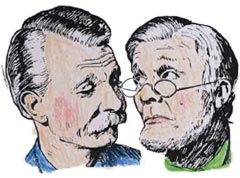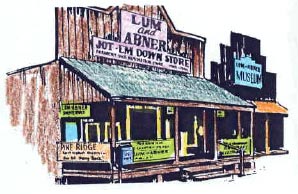"And Now, Let's See What's Going On Down In Pine Ridge...."
SETTING A SPELL WITH LUM AND ABNER
 by Elizabeth McLeod © 2008 by Elizabeth McLeod © 2008
(From Radio Recall, April 2008)
They started out as a rather transparent imitation of the most popular radio show in the country. They became one of radio's most enduring favorites -- and, in fact, their reruns are with us yet.
Chester Lauck and Norris Goff: you know them better as Lum and Abner. For nearly twenty-five years, they were a fixture on the air -- most often in the most humble and yet the most difficult of radio formats: the fifteen-minute nightly comedy serial. And yet, as enduring as they were -- and as beloved as they are today, they spent much of their careers in the shadows of other performers. Part of this is the inevitable results of their own origin.
The story is familiar: Lauck and Goff were hometown entertainers in Mena, Arkansas at the turn of the Thirties who were enlisted to do their blackface act in a local benefit show -- but when they ran into throng of corked-up rivals backstage, they spontaneously switched to a "hillbilly" routine. The rest, the legend would have it, is history.
Success on local radio was soon followed by a network shot, and Lum and Abner were on the way.
The story is true up to a point -- but there's a bit more to it than that.
While both Lauck and Goff were small-town Arkansans, it would be stretching it to claim they were dyed-in-the-overalls mountaineers. Both were college men from prosperous families -- in other words, their background was quite a bit more refined than their characterizations would lead one to expect.
Both Lauck and Goff were sharp; they had been around. They knew what was going on in the world -- and when they suddenly found themselves working in radio, they knew what would work.
Because it was already working, six nights a week, and forty million people were already listening.

(Illustrations by Bobb Lynes)
In 1931, radio “meant” Amos 'n' Andy, the seed from which much of the Golden Age of Radio would sprout. And so it should come as no surprise that when Lauck and Goff began to turn their informal cross-talk routine into a show with network potential that they used the established Amos 'n' Andy format as a very specific model.
It's not too difficult to think of Lum Edwards and Abner Peabody as simply different aspects of Andy Brown: Lum representing his blowhard egotism and Abner his innocent gullibility. Similarly, the solid and reliable Dick Huddleston aptly fills the Amos Jones role. The dull-witted lackey Cedric Weehunt corresponds quite closely to Lightnin' Washington. Grandpappy Spears fits into the plots in much the same manner as Brother Crawford. And of course, the devious Squire Skimp might have learned his trade at the knee of one George "Kingfish" Stevens.
Clearly, when Lum and Abner hit the network air, it was simply one of the legion of comedy serials trying to ride the coattails of the Amos 'n' Andy craze. But what made Lauck and Goff special -- and, in the end, what made them successful -- was the fact that they moved beyond simple imitation to create a unique niche all their own. They took the format they'd appropriated from Freeman Gosden and Charles Correll and infused it with their own distinctive comic vision.
"Comic" is the key word. Early on, Lauck and Goff must have recognized that melodrama was the dominant ingredient in the Amos 'n' Andy formula: listeners were more often on the edge of their seats with anticipation than they were falling off their chairs with laughter.
This was where Lum and Abner was different. Where Amos and Andy struggled thru the stark, often grim business of earning a living in Depression-era Urban America, Lum and Abner lived in a world quite isolated from the realities of the 1930s. Pine Ridge was an escape from the struggles of the Depression, not a reflection of them. And even more, Pine Ridge was a world built on absurdity.
In the creation of loopy nonsense, Lauck and Goff had few peers. Only in Pine Ridge would the citizens eagerly buy discount eyeglasses from a man at the carnival -- and then spend a full week wondering why they kept crashing into each other. Only in Pine Ridge would Lum decide to corner the market on hogs by starting a chain letter -- and then decide to celebrate his success by having a statue of himself constructed from poured concrete. And on and on it went.
 Night after night, Lauck and Goff presented a world where the rules of common sense didn't apply -- and where it was just so easy to forget about those bills you had to pay, that job you didn't have any more, those men from the finance company pulling up the truck outside. When the real world looked like that, who “wouldn't” rather head on down to Pine Ridge? During the thirties, Lum and Abner offered some of the finest pure escapism on the air. Night after night, Lauck and Goff presented a world where the rules of common sense didn't apply -- and where it was just so easy to forget about those bills you had to pay, that job you didn't have any more, those men from the finance company pulling up the truck outside. When the real world looked like that, who “wouldn't” rather head on down to Pine Ridge? During the thirties, Lum and Abner offered some of the finest pure escapism on the air.
As the Thirties gave way to the Forties, all of the comedy serials seemed to start running out of ideas. Amos 'n' Andy abandoned the format entirely in 1943, leaving the field pretty much to Lum and Abner. Lauck and Goff had managed to avoid the burnout which hit Correll and Gosden in the early forties, in part because they were only on three nights a week, and had taken frequent vacations.
They also took the liberty of rerunning entire plot lines from time to time, usually with only a slight rewrite - a "cheater" technique which meant little at the time the shows were originally broadcast, but which can be a bit annoying when listening to the recordings decades after the fact.
Lauck and Goff finally solved their problem by delegating the responsibility of writing the show to others, and the addition of Roswell Rogers to the staff around this time brought an infusion of fresh ideas. Some of the forties-era plots carried on in the finest Pine Ridge tradition - Lum's fake broken leg, the escaped library lion -- while others were just a bit “too” absurd to work: the advent of Robert the Robot, for example.
One of these forties plot lines rose beyond absurdity into the realms of brilliance: 1942's saga of Diogenes Smith and his search for an honest man stands, hands down, as one of the great radio serials of all time -- an expert mixture of high comedy, pathos, philosophy, and social commentary.
Great comedy serials don't often make great situation comedies. They depend too much on the day-to-day flow of the story line and the depth of the characters to translate well into 30-minute weekly doses. Amos 'n' Andy managed the transition only by turning into a completely different sort of program. Lum and Abner tried to stay true to its roots, and the transition flopped.
The half-hour "Lum and Abner Show" of 1948-50 has its moments, but it's nothing special, which is rather sad. Because at its best -- in the serials of the mid-thirties thru the mid-forties -- Lum and Abner was something very special indeed. And because Lauck and Goff were careful to preserve their many thousands of recordings - it still is.
ABOUT THE AUTHOR: Elizabeth McLeod is a journalist, researcher, and freelance writer specializing in radio of the 1930s. She is a contributor to Nostalgia Digest magazine and the Internet Old Radio Mailing List, maintains website, Broadcasting History Resources, and offers paid consultations on matters of broadcasting and popular culture history as well as professional-grade audio transfer and restoration services. Her qualifications may be viewed at http://www.midcoast.com/~lizmcl/resume.html
|